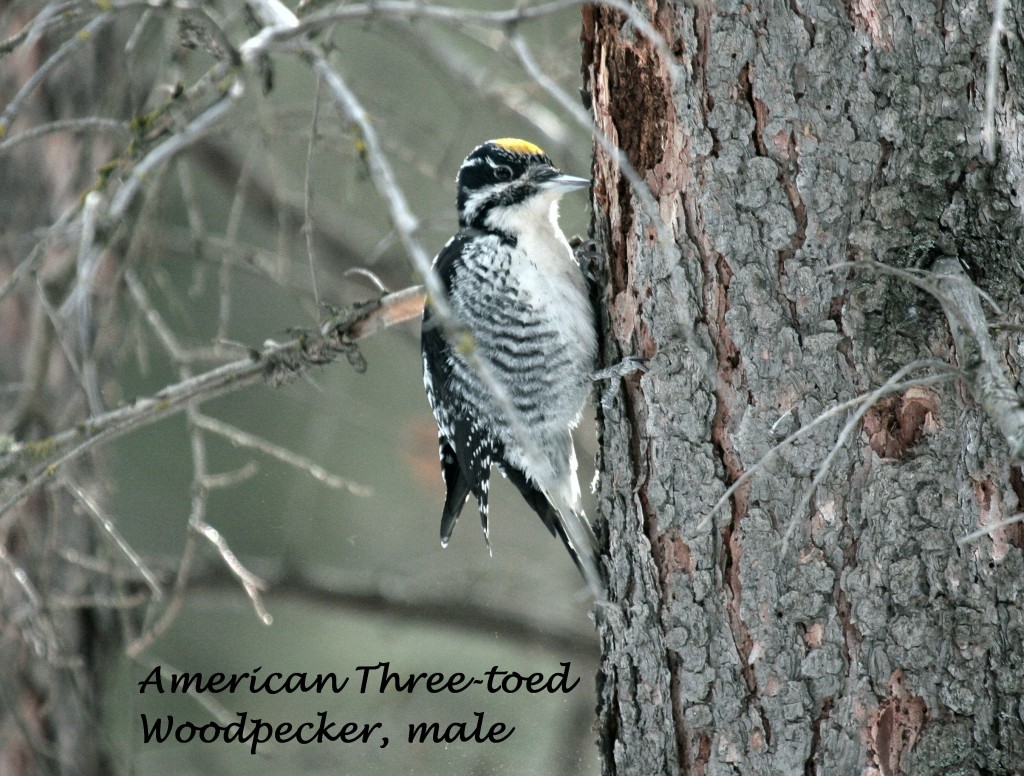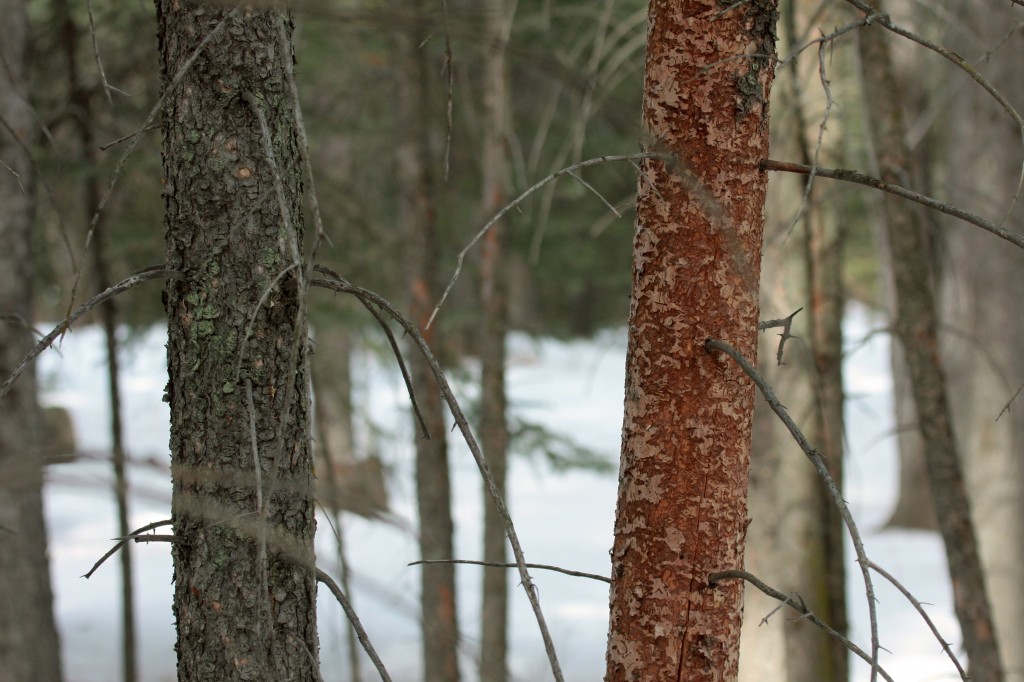This, of course, is the coldest season of the year. Birding demands that you often stop and wait for the birds to show themselves. When standing still, you are not burning calories, therefore not generating heat. On stepping outside in the morning, some folks, thinking that it is relatively mild, decide to wear only a light jacket. After an hour they are chilled to the bone.
To fully enjoy this activity, you must wear enough clothing to keep comfortably warm. It is best to put on lots of layers. Wear a warm cap/hat/toque, for without a head covering you will lose a lot of heat. Be sure to wear warm footwear. If your hands and feet are still cold, it’s because you are losing vital body warmth. If you are cold, you just won’t be able to concentrate — and won’t enjoy the activity. Remember, the birds don’t care what you look like.
Some folks will want to bring a bird book, although the leader usually always has one with him/her.
If you are a note-taker, you may want to bring a notebook and pen(cil). Upon returning home, it is always a good idea to review the bird seen. After each field trip, we’ll also send you (by email), a listing of the species and the approximate numbers of individuals sighted.

Rough-legged Hawk by Anne Elliott
A few rules for these or other birding outings
The purpose of these outing is to see birds. Birds are often best located by hearing them first. Try to limit your socializing to the parking lot. If you are busy chatting, the birds may not be heard. When they are found, some folks cannot even be made aware of their presence because of an ongoing conversation, so will miss out on seeing them altogether.
Unless you are the leader, do not walk ahead of the group. The leader often knows of the presence of a certain bird, but if you go ahead, you may flush it so that no one gets to see it.
Keep together! If the group is strung out, by the time the stragglers catch up, the bird may have flown. Also, if the leader wants to inform you of certain details he/she may tell those at hand and then repeat it when the stragglers arrive, or by then, other observations may distract, so the stragglers miss out entirely. Of course, the leader can wait until everyone is present, but that is wasted time for those who do politely stay together.
Shorter people out front! If you are tall, back off. Don’t block the view it’s hard to see through you unless someone blasts an opening.
About binoculars
Binoculars are a great aid in seeing the beauty of a bird. Once you are used to them, you’ll never leave home without them! I usually have a spare pair in case you forget yours.
Today, there are many kinds of binoculars, ranging in price from $29.00 to $2900.00.
Generally, beginning birders can get by with inexpensive ones. Once you’ve had some experience, you’ll have a better idea of your needs if you want to upgrade.
Binoculars come in many types. Basically they will be marked as 7 X 35, 7 X 42, 8 X 40 or 10 X 50. The first number is the magnification; in other words, they make the object appear to be 7, 8 or 10 times larger or nearer than that registered by your eyes.
The second number is the diameter in millimetres of the large or objective lens of the binoculars. The larger the number, the more light it admits. This may not be significant on a sunny day, but it will be very important on a dull overcast day, or at dawn and dusk.
Generally 7 or 8 power binoculars are ideal for most people. You will get stronger magnification from a 10 power but they usually are heavier. If you cannot hold them steady for long, you have to contend with a greater distortion due to hand vibration.
There are many small opera-type glasses available, such as 7 X 26. Some of these are extremely lightweight and can easily be held by children with small hands. However, as pointed out above, they are not very suitable in low-light conditions. A lens that is only 26mm across lets in only about 25% of the light admitted by a 50mm lens.
Binoculars are made so that one size fits all. However, since we are not all the same, they usually require three settings to match your personal measurements. You need to make these adjustments before using them. Normally you will never have to do so again (unless altered, as when you lend them to others, etc.).
1. Most binoculars have rubber or retractable eyecups. If you wear eyeglasses, fold down the rubber cups or retract the hoods. This will allow your eyes to get nearer to the lens, thus giving you a greater field of view.
2. The distance between people’s eyes vary. The two binocular barrels are hinged so that they can be pushed or pulled apart, to compensate for this difference. When using the binoculars, the barrels should be spaced so that the pupils of your eyes look precisely through the centre of the small lenses. When properly adjusted, your view should be through that of a perfect circle, rather than two overlapping ones. [Note that the top of the hinge has a calibrated dial showing the angle of adjustment. If you recall that setting, you can quickly reset them if someone else uses your binoculars].
3. On most binoculars the right eyepiece (in some models, it is the left one), is adjustable, slightly rotating, to accommodate any differences in your eyes. To adjust for your vision, close or block your right eye while looking through the left eyepiece. It is best to look at a sign, license plate or other flat image about 30 meters away. Between the two barrels there is a centre focusing-wheel or rocker arm. Slowly adjust the centre focusing until you have as sharp an image as possible. Once satisfied that it is perfectly clear, bring your binoculars down for about 30 seconds, to let your eyes rest. Next, looking at the same scene, using only your right eye, rotate the adjustable eyepiece until that image is sharp, too. Again, bring the glasses down. After 30 seconds, now looking through both eyes at the same time, you should have a perfectly sharp image. If not, repeat the above steps until satisfied. [Note that the right eye-piece has a + and – symbol, usually with a few dots between them. On the barrel below, there is usually a white dot. Remember these settings]. [Note, if the adjustable eyepiece is on the left, reverse the order of eye use above].
Once the above steps have been completed, merely rotating the centre wheel will quickly bring any object, near of far, into sharp focus.
After birding for some time, some observers find they are unable to obtain a sharp image. The adjustable eyepiece may have been altered accidentally, perhaps by rubbing against your clothing, etc. An elastic band over the eyepiece and the upper part of the barrel will prevent it from moving.
It could also be that your eye(s) are getting tired. By again following the above steps, you can readjust to sharpen the image.
Your next challenge will be to learn how to aim the binoculars at the correct angle so that you can quickly find the bird in the tree, etc. This takes some practice — but will come naturally with repeated use. Try locating different objects while at home.
While raising your binoculars, keep your eyes on the object. Don’t look down at the glasses while lifting them. Try to memorize the location of the bird by noting how the branches cross, etc. Once you are looking through the binoculars, in the approximate location, quickly focus them (by rotating the centre-wheel) and then search the area where you last saw the bird.
Most binoculars are supplied only with a narrow neck strap. The weight of the binoculars may give some folks a headache. There are a number of harnesses or wider straps that aid in relieving that condition.
If you have further questions, do not hesitate to contact me. In the meantime, I look forward to showing and sharing the birds with you on this upcoming activity.
Gustave J. Yaki, Phone 403-243-2248 or email gyaki@calcna.ab.ca.


























